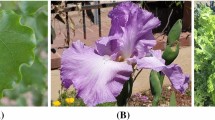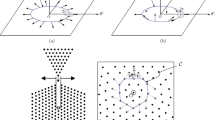Abstract
Hinged lattices that attain extremal values of Poisson’s ratio do not in general obey the theory of elasticity. Hinged structures that attain a Poisson’s ratio of − 1 are easy to stretch or deform volumetrically but they resist bending, in contrast to the predictions of elasticity theory. Their behavior corresponds to that of a Cosserat solid with divergent characteristic length. Hinged structures that attain a maximum Poisson’s ratio are rigid with respect to hydrostatic tension, are easy to shear or to stretch but are unstable with respect to hydrostatic compression.







Similar content being viewed by others
References
Sokolnikoff, I.S.: Theory of Elasticity. Krieger, Malabar, FL (1983)
Almgren, R.F.: An isotropic three dimensional structure with Poisson’s ratio = -1. J. Elasticity 15, 427–430 (1985)
Lakes, R.S.: Foam structures with a negative Poisson’s ratio. Science 235, 1038–1040 (1987)
W.T.B. Kelvin, Mathematical and Physical Papers: 1841–1890, vol. 3. Cambridge University Press; J. J. Clay and sons, University Press, London, 1890. XLVI, On a gyrostatic adynamic constitution for ‘ether’, pp. 466–472, reprinted from Edinburgh Royal Society, Proc. Vol. xvii., pp. 127–132 March 17 (1890)
Stuart, D.: Polyhedral and mosaic transformations. Student Publications of the School of Design, North Carolina State University 12(1), 2–28 (1963)
Wells, D.: Hidden Connections. Double Meanings. Cambridge University Press, Cambridge (1988)
Frederickson, G.N.: Hinged Dissections. Cambridge University Press, Cambridge (2002)
Wojciechowski, K.W.: Constant thermodynamic tension Monte Carlo studies of elastic properties of a two-dimensional systems of hard cyclic hexamers. Mol. Phys. 61, 1247–1258 (1987)
Wojciechowski, K.W.: Two-dimensional isotropic system with a negative Poisson ratio. Phys. Lett. A 137, 60–64 (1989)
Sigmund, O.: Materials with prescribed constitutive parameters: an inverse homogenization approach. Int. J. Solids Struct. 31(17), 2313–2329 (1994)
Ishibashi, Y., Iwata, M.: A microscopic model of a negative Poisson’s ratio in some crystals. J. Phys. Soc. Jpn. 69, 2702–2703 (2000)
Grima, J.N., Evans, K.E.: Auxetic behavior from rotating squares. J. Mater. Sci. Lett. 19, 1563–1565 (2000)
Grima, J.N., Alderson, A., Evans, K.E.: Auxetic behaviour from rotating rigid units. Phys. Status Solidi B 242, 561–75 (2005)
Grima, J.N., Evans, K.E.: Auxetic behavior from rotating triangles. J. Mater. Sci. 41, 3193–3196 (2006)
Attard, D., Grima, J.N.: Auxetic behaviour from rotating rhombi. Phys. Status Solidi (b) 245, 2395–2404 (2008)
Attard, D., Grima, J.N.: A three-dimensional rotating rigid units network exhibiting negative Poisson’s ratios. Phys. Status Solidi B 249(7), 1330–1338 (2012)
Andrade, C., Ha, C.S., Lakes, R.S.: Extreme Cosserat elastic cube structure with large magnitude of negative Poisson’s ratio. J. Mech. Mater. Struct. (JoMMS) 13(1), 93–101 (2018)
Milton, G.W.: Complete characterization of the macroscopic deformations of periodic unimode metamaterials of rigid bars and pivots. J. Mech. Phys. Solids 61, 1543–1560 (2013)
Milton, G.W., Cherkaev, A.V.: Which elasticity tensors are realizable? ASME J. Eng. Mater. Technol. 117, 483–493 (1995)
Milton, G.W.: The Theory of Composites. Cambridge University Press, Cambridge (2002)
Kapco, V., Treacy, M., Thorpe, M.F., Guest, S.D.: On the collapse of locally isostatic networks. Proc. R. Soc. Lond. A 465, 3517–3530 (2009)
Klein, C.A., Cardinale, G.F.: Young’s modulus and Poisson’s ratio of CVD diamond. Diam. Relat. Mater. 2, 918–923 (1993)
Gibson, L.J., Ashby, M.F.: Cellular Solids, 2nd edn. Pergamon, Oxford (1997)
Zhu, H.X., Knott, J.F., Mills, N.J.: Analysis of the elastic properties of open-cell foams with tetrakaidecahedral cells. J. Mech. Phys. Solids 45, 319–343 (1997)
Lekhnitskii, S.G.: Theory of Elasticity of an Anisotropic Body. Mir, Moscow (1981)
Cosserat, E., Cosserat, F.: Theorie des Corps Deformables. Hermann et Fils, Paris (1909)
Eringen, A.C.: Theory of micropolar elasticity. In: Liebowitz, H. (ed.) Fracture, vol. 1, pp. 621–729. Academic Press, New York (1968)
Lakes, R.S., Drugan, W.J.: Bending of a Cosserat elastic bar of square cross section—theory and experiment. J. Appl. Mech. (JAM) 82(9), 091002 (2015)
Gauthier, R.D., Jahsman, W.E.: A quest for micropolar elastic constants. J. Appl. Mech. 42, 369–374 (1975)
Krishna Reddy, G.V., Venkatasubramanian, N.K.: On the flexural rigidity of a micropolar elastic circular cylinder. J. Appl. Mech. 45, 429–431 (1978)
Mindlin, R.D.: Effect of couple stresses on stress concentrations. Exp. Mech. 3, 1–7 (1963)
Lakes, R.S.: Saint-Venant end effects for materials with negative Poisson’s ratios. J. Appl. Mech. 59, 744–746 (1992)
Gibson, L.J., Ashby, M.F., Schajer, G.S., Robertson, C.I.: The mechanics of two dimensional cellular solids. Proc. R. Soc. Lond. A382, 25–42 (1982)
Kolpakov, A.G.: On the determination of the averaged moduli of elastic gridworks. Prikl. Mat. Mekh. 59, 969–977 (1985)
Rueger, Z., Ha, C.S., Lakes, R.S.: Flexible cube tilt lattice with anisotropic Cosserat effects and negative Poisson’s ratio. Physica Status Solidi B 256, 1800512 (2019)
Rueger, Z., Lakes, R.S.: Strong Cosserat elasticity in a transversely isotropic polymer lattice. Phys. Rev. Lett. 120, 065501 (2018)
Rueger, Z., Ha, C.S., Lakes, R.S.: Cosserat elastic lattices. Meccanica 54(13), 1983–1999 (2019)
Acknowledgements
We acknowledge partial support by the National Science Foundation via Grant No. CMMI -1906890.
Author information
Authors and Affiliations
Corresponding author
Additional information
Publisher's Note
Springer Nature remains neutral with regard to jurisdictional claims in published maps and institutional affiliations.
Rights and permissions
About this article
Cite this article
Lakes, R.S. Extremal hinged lattices do not obey the theory of elasticity. Z. Angew. Math. Phys. 73, 27 (2022). https://doi.org/10.1007/s00033-021-01664-x
Received:
Accepted:
Published:
DOI: https://doi.org/10.1007/s00033-021-01664-x




